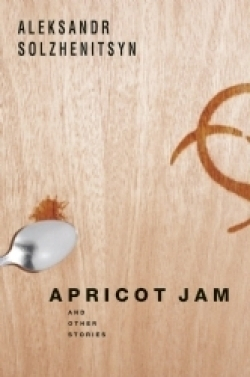Apricot Jam
and Other Stories
From the Nobel-winning pen of the late Aleksandr Solzhenitsyn, Russian writer, dramatist, and historian, come eight short stories newly translated into English, which portray social, political, and military conditions during the height and the decline of the Soviet regime. Solzhenitsyn is best known for exposing the Gulag, the Soviet Union’s forced labor camp system, and as a result of his controversial work, he was forced to leave Russia from 1974 until 1994. He composed the works in Apricot Jam during the 1990s, after he returned from exile.
Through the stories in Apricot Jam, Solzhenitsyn recognizes the diverse viewpoints and various institutions that played a role in modern-day Russia’s fate as a nation; therefore, he creates characters with a passion for war or bureaucracy, as well as professors, prisoners, peasants, and writers. He captures the hope-filled plight of the proletarian class, tracing both their achievements as they ascend the socioeconomic ladder, as well as their stoicism toward oppression.
Solzhenitsyn’s military officers, students of science and technology, and young mothers all share a desperate longing for betterment in the future, whether it be from the manifestation of communist or socialist ideology that benefits all, the end of Bolshevik dictatorship, a new generation of godless, avant-garde, class-conscious individuals (described in “A New Generation”), or the ability to “change” one’s “social origins.” Some characters devote their bodies and minds to affecting change, such as soldiers “taught by the book” who experience “joyous exhaustion” from battle and revel in the “delight of war.” Yet there is also a motif of passivity in Solzhenitsyn’s stories; characters take note of clouds covering the moon, and this becomes a symbol for their fate as they wait for them to part—and for the light of hope to appear.
Each story is constructed in a “binary” fashion, with two parts (except for one that is divided into twenty-four parts corresponding to the hours in one day). Solzhenitsyn selects this style for purposes of juxtaposition, or to signify the passage of time; some of his characters even have the same name, despite differing circumstances, and he compares them with regard to setting or their social or political standing. The English translation is meticulously crafted, and colloquial expressions are adapted in a way that is comfortable for the American reader.
The first story, “Apricot Jam,” depicts an ailing young kulak man who recalls an apricot tree that grew in the yard of his family home. His mother often made jam from its fruit before officials raided the village, detained his family, and chopped down the tree as part of an interrogation threat. His writings are an outcry for someone to take pity on his condition. In part two, a pair of men discuss their own writings with regard to the revolution of language and literature in a corrupt, politicized society. They define a “new type of literature” as “the epic of a classless society” as they sip afternoon tea and enjoy pastries with cherry and apricot jams.
Like the characters in his stories which aspire to compose written records of the political landscape, Solzhenitsyn strives to create an “honest, worthy account of it all,” from the onslaught of World War I to the beginning of the Cold War, when the Russian manufacturing industry plummets and threats of privatization abound. The stories complement one another to reveal a country in which a government struggling to gain absolute control simultaneously regulates and disregards its citizens. The stories in Apricot Jam are the stories of both advocates and victims of such a society. And for many, there’s only one way out—and that’s “the Russian way—by guess and by God.”
Reviewed by
Lydia Belanger
Disclosure: This article is not an endorsement, but a review. The publisher of this book provided free copies of the book to have their book reviewed by a professional reviewer. No fee was paid by the publisher for this review. Foreword Reviews only recommends books that we love. Foreword Magazine, Inc. is disclosing this in accordance with the Federal Trade Commission’s 16 CFR, Part 255.

